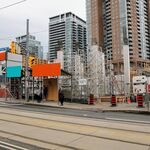What disbursed me is the day contactor who has perform on time on all the other projects in the pas is far behind on this for some reason other the hold up by Toronto Hydro which is standard for them and other utilities beyond their control. It could be a case where TTC is delaying the work due lack of funds or not having the man power to do the work when things were ready for them.
Regardless of various delays, can't see why that retaining wall hasn't been built months ago when first form.
Based on info pertaining to Finch Guideway and told many times in the past how slow TTC trackwork is done, they sent me an link to a 2.5 Km area that was totally rebuilt in 18 days including a new platform. Work took place on an 7/24 which rarely take place here.
I have question TTC current method for track work if it is the best way to go doing the 29-50-100 year replacement claim by TTC. My ride on 501 on Thursday is saying the 20 year plan is not working so far as well an number of other locations.
Seeing Finch trackwork, it becomes the 6th method for trackwork. Considering that the Finch method has only been around 30 years, it has a leg up on TTC method at this time. While have to wait until the is in full service to hear the sound from the trackwork compare to TTC method.
As to the grouting I was seeing for the line, it looks like it's the Dutch Edilon Sedra embedded rail track system that is being used, This uses a Corkelast grout to hold the rails into slots in a concrete track bed (
https://youtu.be/KOE5LpQDKRM)
In Canberra a highway slip form paving machine was used to build most of the track from complete with the slots for the rail insertion. This speed up the construction time, except that the slip form paver wasn’t able to be used in any locations where there needed to be additional equipment inserted in the track slab such as drains, signalling transponders, stray current collection terminals etc.
They also ship prefabricated guideway as one section 30m long and drop them in place on either side of various things that can't be done prefabricated section.
Video of work on route 96 done in 18 days.




















